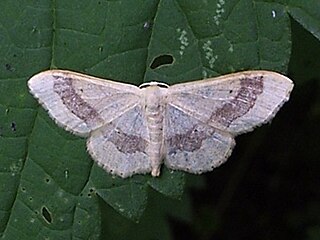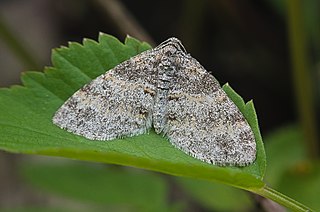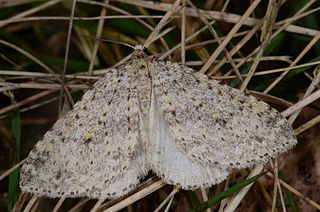
The riband wave is a moth of the family Geometridae. The species was first described by Carl Linnaeus in his 1758 10th edition of Systema Naturae.

The common pug(Eupithecia vulgata) is a moth of the family Geometridae. It is a common species across the Palearctic region, including the Near East and North Africa. It ranges from the Atlantic coast of Ireland and Portugal across Europe, the Middle East and Central Asia to the Russian Far East (Priamurje) and Korea.

The tawny speckled pug is a moth of the family Geometridae.

Larentiinae is a subfamily of moths containing roughly 5,800 species that occur mostly in the temperate regions of the world. They are generally considered a subfamily of the geometer moth family (Geometridae) and are divided into a few large or good-sized tribes, and numerous very small or even monotypic ones which might not always be valid. Well-known members are the "pug moths" of the Eupitheciini and the "carpets", mainly of the Cidariini and Xanthorhoini. The subfamily was described by Philogène Auguste Joseph Duponchel in 1845.

Eupithecia innotata, the angle-barred pug, is a moth of the family Geometridae. The species was first described by Johann Siegfried Hufnagel in 1767. It ranges from Spain in the west to western Siberia and Central Asia in the east.

Lobophora halterata, the seraphim, is a moth of the family Geometridae. It was first described by Johann Siegfried Hufnagel in 1767. The species can be found in central and northern Europe and a few localities in southern Europe, Siberia, Amur, Primorye, Sakhalin and Japan.

Thera firmata, the pine carpet, is a moth of the family Geometridae. It is found throughout Europe, Anatolia and countries bordering the Caucasus Mountains.

Eupithecia simpliciata, the plain pug, is a moth of the family Geometridae. It is found in the Palearctic realm, from western Europe to north-western China (Xinjiang). The species primarily colonizes wastelands, rubble and abandoned vineyards, and in Asia also salt steppes. In the Alps, the range of altitude extends up to 1200 metres.

Thera obeliscata, the grey pine carpet, is a moth of the family Geometridae. It is found throughout north and central Europe and east across the Palearctic to Siberia, and south to the Caucasus and Transcaucasia. In the Alps it can be found at an altitude of over 1500 metres.

Cosmorhoe is a monotypic moth genus in the family Geometridae erected by Jacob Hübner in 1825. Its only species, Cosmorhoe ocellata, the purple bar, was described by Carl Linnaeus in his 1758 10th edition of Systema Naturae.

Coenotephria salicata, the striped twin-spot carpet, is a moth of the family Geometridae. It was first described by Michael Denis and Ignaz Schiffermüller in 1775 and is found in most of Europe.

Carsia sororiata, the Manchester treble-bar, is a moth of the family Geometridae. The species was first described by Jacob Hübner in 1813. It is found in northern and central Europe, the Urals, Siberia, the Far East, northern Mongolia and in North America from Alaska to Newfoundland and to New Hampshire.

Epirrhoe galiata, the galium carpet, is a moth of the family Geometridae.

Euphyia biangulata, the cloaked carpet, is a moth of the family Geometridae. It is found in most of Europe and the Middle East.

Colostygia multistrigaria, the mottled grey, is a species of moth in the family Geometridae. It is found in western and south-western Europe and North Africa. The habitat is damp woodlands, heaths, and mosses.
Eupithecia spinibarbata is a moth in the family Geometridae. It is found in India (Darjeeling).
Eupithecia phantastica is a moth in the family Geometridae. It is found in Zhejiang in China and in Taiwan.
Eupithecia julia is a moth in the family Geometridae. It is found in western China (Sichuan).
Eupithecia phaea is a moth in the family Geometridae. It is found in Mongolia.
Eupithecia efferata is a moth in the family Geometridae. It is found in Pakistan.
















